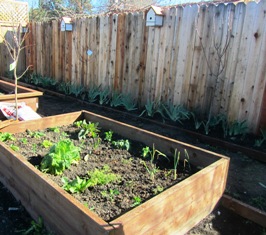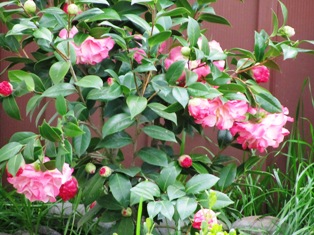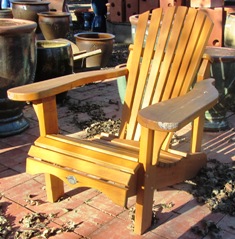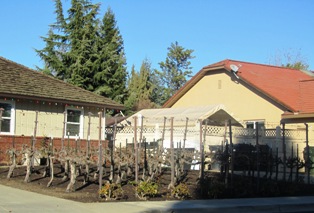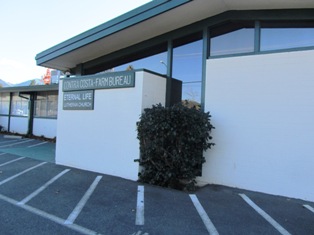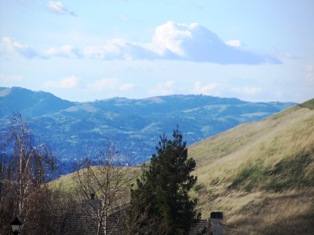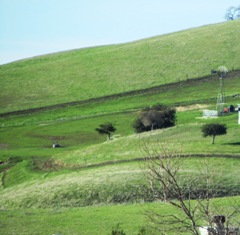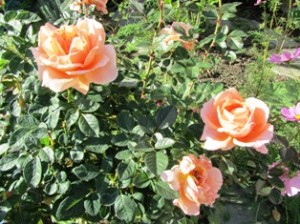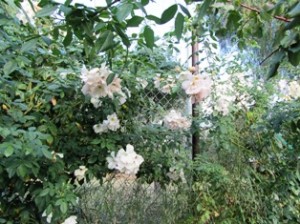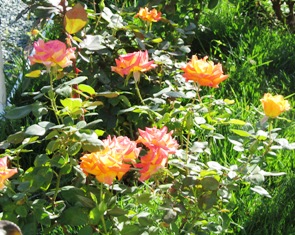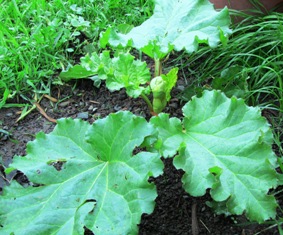Archive for the 'Uncategorized' Category
Organic Amendments to Benefit Soil
There are many ways to improve soil composition to grow healthy plants. Healthy plants produce more abundant and bigger yields.
The soil on the Henny Penny Farmette is mostly heavy clay. After a rain, its sticks together like solid, cold mass of margarine. In the summer, it hardens like concrete and also cracks.
To make soil more porous, it is necessary to add amendments that permit air circulation and water penetration and retention.
There are basically two different types of amendments. The mineral amendments such as vermiculite, pumice, and perlite are generally used in sandy soil to create aeration and water retention. Types of organic amendments for soil such as our clay soil include manure, leaf mold, ground bark, peat moss, and sawdust. These rely on bacterial action to break down into a soft, crumbly humus.
In our vegetable growing boxes that are 4 feet by 6 feet, we include 25 percent organic amendments to 75 percent soil. Sometimes we even up the percentage of amendment material. We turn it thoroughly.
The clay soil immediately benefits from the tilling (adding air) and also from the blending of organic material into the soil to change its density, nutrient value, and permeability to water.
Raised beds, which I first saw on farms in villages along the Volga in Russia, allow us to control the soil and makes it easier to add amendments and mulch. However, we also have garden beds, too, that benefit from organic amendments.
Late January Garden Chores
With spring only two months away, there is still plenty of work to be done in Northern California gardens. The following is my list of things to do on the Henny Penny Farmette.
Apply iron sulfate to acid-lovers
Camellias belong to a group of plants that thrive in soil with a pH balance that is acidic. Examples of a some other acid-loving plants include azaleas, begonias, caladiums, gardenias, hydrangeas, impatiens, Japanese maples, jasmine, and primulas, to name a few.
This time of year I give these plants an application of iron sulfate to maintain the plant’s green color. My blueberry bushes and citrus trees also benefit from receiving an application of iron sulfate or the non-staining Iron Plus.
Build or purchase compost bins and raised-bed earth boxes
Every garden needs compost and bins make it easy to produce that nutrient rich material that plants love. This is the time to build or buy compost bins and also the raised bed boxes. We’ve put in eight and have plans to build more.
Prune fruit trees
Prune fruit trees for shape and also to produce fruit. For example, I cut back the peaches and nectarines by about 2/3 of last year’s growth. The new growth bears only once. Hence, the need for vigorous pruning. I cut back the apricots by about 1/3 of last year’s growth, paying special attention to any spurs (usually productive for three to five years). Branches with spurs that age will have to be replaced by cutting them away so the tree can produce new branches with fruiting spurs.
Fruit and nut trees that require very little pruning (mostly to eliminate dead wood or crossing branches) include cherries, apples, pears, and almonds. I tend to cut away small branches of the almonds. The nuts will be born on new spurs and shoots.
Apply dormant oil to roses
Roses, once they’ve been pruned, need an application of dormant oil such as Bonide All Seasons Spray Oil (for organic gardens). The oil is beneficial for eliminating over-wintering pest populations by smothering the pests’ eggs. To halt fungus-precipitated diseases like rust, blackspot, and powdery mildrew, spray roses with liquid copper.
Dress the lawn with a winter fertilizer
Feed the lawn with a good quality lawn fertilizer to keep it green, growing, and resistant to rust and diseases arising from malnutrition.
Spray liquid copper to curb Peach Leaf Curl
An application of liquid copper keeps peaches and nectarine trees resistant to the disfiguring curling of new leaf growth.
I know that the work I do now in the garden will pay big dividends when warm weather arrives and the chores of planting and tending vegetables begins. The above list is my garden chores checklist for this time of year. Feel free to use it to build a checklist for your garden.
Visiting a Favorite Nursery to Check on New Offerings
Seed catalogs are fun to read, but what better way to start off the new year than with a visit to a local nursery. Our favorite is Alden Lane Nursery, in Livermore, California, about 15 miles from the Henny Penny Farmette. See, http://www.aldenlane.com.
There are many reasons why I like this nursery. For starters, it offers over 200 varieties of roses, one of the largest rose collection I’ve ever seen in any of our local nurseries. The nursery maintains a large number of David Austin and Romantica roses.
I grew three dozen different roses in San Jose and here on the farmette, I’ve already planted about two dozen floribundas, grandifloras, hybrid teas, and climbers. I especially love my Abbaye de Cluny and A Shropshire Lad roses. These two are beautiful roses, nearly carefree, and reward us with gorgeous blooms.
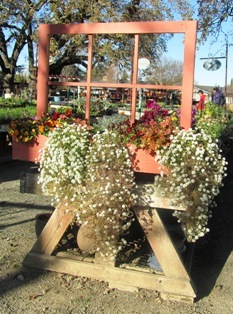
A window frame, painted and screwed to a rectangular box, can be mounted on a shed wall for interest in the garden
During my visit to Alden Nursery, I spotted lots of pots and yard art as well as a variety of different fruit trees espaliered on trellises. It got me thinking that perhaps and apple grafted with several varieties and trained as an espalier might look attractive against the wall of my chicken house.
An espaliered fruit tree is one in which the branches of the tree are trained against a wall or other support and are prune in such a way as to allow the fruit to grow along its cordons. Read more about espaliered fruit trees at http://www.pallensmith.com/articles/espaliered-fruit-trees.
Alden Nursery staff suggest the following garden chores be done in January and February: plant seed potatoes, prune fruit trees, apply iron sulfate to promote green color in acid loving plants, feed the lawn, plant new camellias, and add three to four inches of mulch around the bases of trees and shrubs, and ensure that frost tender plants are protected against plummeting temperatures.
Other chores include applying aluminum to soil to change a pink hydrangea to blue (or use the Hydra Blue product), spraying roses with Bonide All Seasons Spray Oil (it’s plant-based for organic gardens), and pruning evergreen shrubs.
Before leaving the nursery, I snapped a picture of an Adirondack chair. My architect-in-residence (also known as my spouse) is a whiz at looking at something and then making it. I explained to him how happy it would make me if we could create a pair of similar chairs for my garden from recycled materials.
On the way home, we passed some open fields with land for sale. Perched on a post was a Cooper’s hawk (although I’m not entirely sure about this identification). The hawk did not shift its position, and I could not see any shoulder or tail bands or back markings. It had a fairly tubular body and thin legs but no red eyes. If you know what kind of hawk it is, please let me know.
Livermore Valley is making a name for itself as a significant wine region south of Napa. The valley is home to many vineyards and wine aficionados. As we drove away from the nursery, we spotted a little vineyard tucked into a resident’s front yard. It was altogether a lovely day for a visit to the nursery. We’ll return in two weeks when the staff has put out all the new bare-root fruit trees, berries, and grapes. Until then, I’ll be reading the seed catalogs stacked on my desk.
Transitioning between the Seasons
Now that we’ve entered a new year and a new season, I’ve reluctantly pulled the last of the chili pepper plants from my garden. This past summer I grew Anaheim, ancho, chiles de arbol (hot and related to cayenne), banana (also known as yellow wax peppers), and jalapeno (called chipotle whenever the chilies are smoked). I save the seeds in white paper envelopes for replanting and use the chilies in cooking my Hispanic, Caribbean, Indian, Southwestern, and Thai dishes.
Cooks the world over love chilies for the flavors they add to their cuisines, however, chilies contain oils that can irritate skin and eyes. When harvesting seeds from chili peppers, I wear latex gloves (like surgeons wear). The gloves protect my fingers and hands from the oils but allow me to easily work with the chilies.
A little tip about gauging the heat of chilies is to look at the top (shoulder) and tip (pointed end). If the top is wide and the tip is blunt, the chili will be milder than a chili with a narrow top and a pointed end. See, http://whatscookingamerica.net/chilepep.htm.
I opted not to put in winter season crops this year. The clay soil needs turning (with a rototiller) and more amendments. With the vegetable garden devoid of plants now except for vagrant lettuces, carrots, and potatoes, I do winter clean-up chores such as composting, pruning, and preparing beds for spring.
The Bay Area forecast for the inland valleys last night predicted plunging temperatures and a hard freeze. I covered the citrus trees with blankets and a heavy sheet of black plastic. At sunup, the temperatures still hovered around 30 degrees Fahrenheit, and white hoar frost covered everything in the garden, including the sheeting.
A garden needs winter–a time of rest, dormancy, and chill. Some plants require many hours of chilling to perform well. Freezes also eliminate some garden pests.
Our neighbor graciously gave us some bulbs a year ago that we planted in the fall. Now they’ve sprouted and are blooming. These white jonquil blooms are similar to those grown in my mother and grandmother’s gardens (although their jonquils were yellow with orange-yellow centers). The blooms add welcome color to the otherwise monochromatic winter landscape. These and other bulbs we’ve planted will eventually render some color in the garden and hopefully a little pollen for the honeybees while we wait for winter to transition into spring.
Learning about the Local Farm Bureau
I have passed the one-story stucco building at 5554 Clayton Road (#1) a gazillion times on my way to the post office and didn’t know until recently that it housed the Contra Costa County Farm Bureau. So today I stopped in for a visit.
Our farmette lies within one mile or so of designated California agricultural land. That means there are a lot of ranches and family farms in the area. In fact, most days, we can see cattle grazing on the verdant hills and pasture lands that surround us. Where there are ranches, there is likely a farm bureau.
The Contra Costa County Farm Bureau is supported by members, many of whom are ranchers and farmers in the county. The bureau’s efforts focus on maintaining the county’s agricultural heritage, promoting responsible land use, preserving open space, promoting confidence in food safety, and also supporting “Buy Fresh, Buy Local.”
“Buy Fresh, Buy Local” means that money spent on locally produced products keeps the money circulating in our community. The farmer’s markets provide great exposure for local small businesses. Concord offers two locations for its farmer’s market. The main one is at Todos Santos Plaza, the downtown park around which our small city is built. Last year, Concord High became the secondary location.
The Contra Costa County Farm Bureau works with 52 other county farm bureaus to protect California’s agriculture interests, including informing farmers about farm issues before the California Legislature. It keeps members updated on the latest issues of concern through its Farm Bureau Times newsletter. The August 2012 issue contains a comprehensive listing of the county’s year-round certified farmer’s markets.
The California Farm Bureau Federation publishes AgAlert, the weekly newspaper for California Agriculture. The latest issue provides 28 pages of information spanning diverse topics, including legislation, crop infestation and treatment, organic farming, water issues, range land conservation,and almond exporting.
Our Contra Costa Farm Bureau maintains a program for educating students about keeping bee hives, growing vegetables from seeds, seeing farm animals up close, and learning about the history of livery stables and early farming in California. For more information, contact the Bureau at 925-672-5115. If you have a local small business involving agriculture, consider joining your local farm bureau.
Slow Moving Storms Saturate the Farmette
The meteorologists on Bay Area television warned for a week that a series of slow-moving storms would hit the region in a one, two, three punch. One weather forecaster explained that the cloud cover of the storms stretched from San Francisco to Hawaii. On our Henny Penny Farmette, the storms dropped a lot of water but the septic handled the deluge well.
Over the summer months, we had relocated mounds of earth to strategic areas so the water of these types of winter storms would flow away from the house. A walk around the farmette today convinced me that we did the right thing. Mostly, the water stayed away from the house foundation. Also, the French drain that encircles the perimeter of the house seems to be working well.
Still, the storms that dropped nearly eight inches of rain in the north bay, triggering emergency flash flood warnings for local streams and rivers, also saturated our farmette. Water pooled on some of our gravel paths. The largest reservoir of standing water is in front of the house. That area has been excavated for construction of our wrap-around porch and steps.
After enduring a hot, dry summer, the plants that are wintering over seem to come alive in the rain. In particular, the irises in beds around the farmette are starting to bloom. The French perfume lavender is also sending forth purple flower spikes. Whether it is summer heat cracking the ground or winter rains that saturate and flood it, each season has challenges but also offers gifts. To live in harmony with Mother Nature is be accepting and ever-mindful of the way nature achieves balance.
Inviting Nature in through a Kitchen Garden Window
At only 1,000 square feet, our farmhouse, at times, felt claustrophobic to me after we moved here in 2010. I needed windows and lots of light. I wanted hardwood floors and granite countertops. But I also wanted to reuse, recycle, and do the work as inexpensively as possible. My husband Carlos is an architect and I’m his number one (dare I say visionary) helper. Together we’ve done remodels on both coasts, so a little farmhouse should be no problem, right? We had no idea how much work was (and still is) ahead of us.
Fans of network television home improvement shows will tell you that if you ever want to make your money back on a renovation, fix the kitchen and the bathrooms. So, of course, those were high on our list of priorities. Rotting wood and mountains of broken ceramic tile had to be carted away before we could even start our interior work. But we did put in a marble kitchen floor. Carlos laid it out in a pretty pattern. It looks lovely, is easy to keep clean, and feels cool under bare feet in the summer.
Finally, we began to slowly and methodically open up the space. Inside the kitchen, we installed the back splash of Italian honed marble that we bought at a closeout sale. We reused the garden window. For me, windows are a lovely way to link indoor with outdoor space. Framing the window and adding a flourish of crown molding finished it off nicely. Now I can look out on a maple tree, roses, and lavender planted along the fence line when I do dishes. Anchored in front of that window, I incubate my ideas for my books and dream of what renovation project to tackle next.
Iris Reward with Sensational Spring Blooms
Few flowers do the double duty of iris in a flower garden. They provide a great background for other flowers and also produce exquisite blooms on their tall stems. Both bearded and beardless iris plants provide textural interest for other perennials, annuals, and herbs, whether in a formal or informal flower bed, along a walkway, or tucked into a corner of a garden.
Iris produce their blooms on stalks that emerge from clumps of stiff, erect, spiked, and pointed green leaves. My iris plants were a gift from the neighbor who owns the property behind the Henny Penny Farmette. The bulbs she gave me had originally been planted by her father and mother, both now deceased. We were thrilled to get the bulbs.
When we planted them on our property, we made sure the soil was amended and we sprinkled in some bone meal and watered well. Then the iris were left alone. We did apply mulch prior to the winter rainy season and because here in the inland valley of the east bay, we can get freezing nighttime temperatures. Those iris plants have rewarded us with spectacular blooms in April each year.
We didn’t know if the bulbs would produce a true blue bloom or some other color, so the anticipation was killing us that first year. Then the buds emerged on tall (roughly three foot stalks) and we could see what was coming. I have to say, the blooms bedazzled us.
Plant height separates the bearded iris into roughly five groups: miniature dwarf, standard dwarf, intermediate, miniature tall, border, and standard tall. Our iris plants fall into the standard tall category. The best time to plant the iris rhizomes is from July to September 15. Set the rhizomes just beneath the soil surface as they do not like being planted too deep. In really cold areas, a thick layer of mulch ensures the rhizome survives alternate freezes and thaws. Lift and divide the rhizomes right after blooming. You can cut the leaves back to six inches for ease in handling the plants.
A note about rhizomes: These thick horizontal stems generate roots from the bottom and the plant’s leaves and flowers emerge from the top. Some plants that grow from rhizomes are bearded irises, calla lilies, and cannas.
Roses Add Romance to a Garden
Years ago, I wrote a book about interior decorating using flowers and floral motifs. I drew upon my appreciation of flowers to research and write that book with gal pal A. Bronwyn Llewellyn, author of Goddess at Home (interiors inspired by Greek goddesses). Because I so love the faded elegance of an English country motif where chintz and vintage floral designs reign supreme, I have included many types of old floral favorites as well as rose bushes around the Henny Penny Farmette.
Abbaye de Cluny (pictured above) seems to enjoy being tucked in a bed that includes French perfume lavender, rose geranium, cosmos, and Spanish lavender, and has become my favorite rose. It displays its splendor in the garden near my patio door where I can gaze upon it often. My son Josh gave me this rose for Mother’s Day 2011. Abbaye de Cluny offers a spicy citrus scent and about 30 petals in each apricot bloom. When mature it will reach four feet tall and spread to three feet wide. It likes full sun and well-drained soil. Abbaye de Cluny is a super easy rose to grow.
Another lovely rose that I started from a cutting, using root hormone and sticking the cutting directly into the ground as the winter rains started, was Climbing Sally Holmes. In two years, that rose has evolved into a ten foot bush that sprawls on the back fence. I’ve since taken other cuttings from it and started that rose in other areas. This Jackson & Perkins rose is a antique hybrid musk with three and one-half inch, long-lasting blooms. It provides drama for any setting, but especially a garden sitting area.
For me, a rose gives two gifts–its scent and its bloom. I usually won’t plant a rose that doesn’t hold the promise of both, however, I made an exception with a floribunda named Redgold. This rose is a show-stopper with its fiery dual coloring of red and gold. Its petal count is around 25 on blooms that are much smaller than the Abbaye de Cluny. But in a flower bed that includes climbers and hybrid teas, this rose holds its own. It likes to be feed a fish emulsion tea; I only water it as needed.
I do not spray any of my roses and because there is a healthy ecological balance in my garden (lots of lady bugs and praying mantises to feed on aphids and other pests), so far the roses are performing beautifully without human intervention.
Hardy Rhubarb Heralds Spring
I will never forget the long and tortuous Missouri winters of my youth when for days on end the gray sky seemed to hang as low as the horizon line. With hope and great anticipation of nature’s renewal, I waited on spring. Inevitably I would notice the green shoots of tulips, grape hyacinths, and paper white narcissus pushing up through the cold earth.
Gradually, the gray lifted revealing blue. The earth warmed. The strawberries swelled and ripened. The spring peepers kept a chorus down by the pond. Then, inevitably, my grandmother would grab a basket and motion for me to join her in the garden. There we twisted and pulled thick red stalks of rhubarb–one of the earliest vegetables of spring–for pie-making. Grandma always served a dessert at every meal, even breakfast when the white icing she had slathered on just-baked cinnamon rolls would cascade down like melting snow.
So it might not come as a surprise to people who know me that when my husband and I talked about what vegetables we would include in our Henny Penny Farmette garden, I told him rhubarb for jam, jelly, and, of course, pies like my grandmother used to make. We waited until our second year here to put in the rhubarb, and we will let the plants grow for at least a year before harvesting. Next spring, we expect to be able to harvest stalks that are at least an inch thick, possibly for one to two months.
If you’ve never grown rhubarb, you need to know that rhubarb leaves are poisonous. Only the celerylike stalks, with their tart (but also sweet) flavor are used for cooking. You also won’t grow rhubarb from seed but rather from root divisions obtainable at your local nursery. Plant the root divisions (also called crowns) in holes that are about three feet deep and three feet wide and include compost and aged manure with soil. Use mulch to keep the roots moist and to protect them during a hard freeze.
I love the elephant ear-sized leaves and the red stalks (although the stalks can also be green). Best of all, the plant is easy to grow and almost pest free. My favorite variety of rhubarb is the Cherry Red because it is a prodigious producer and has an intensely sweet flavor.
 Facebook
Facebook Goodreads
Goodreads LinkedIn
LinkedIn Meera Lester
Meera Lester Twitter
Twitter




